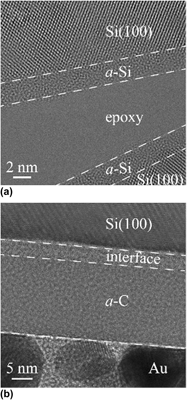Crossref Citations
This article has been cited by the following publications. This list is generated based on data provided by
Crossref.
Mangolini, Filippo
McClimon, J. Brandon
Rose, Franck
and
Carpick, Robert W.
2014.
Accounting for Nanometer-Thick Adventitious Carbon Contamination in X-ray Absorption Spectra of Carbon-Based Materials.
Analytical Chemistry,
Vol. 86,
Issue. 24,
p.
12258.
Rose, Franck
Wang, Na
Smith, Robert
Xiao, Qi-Fan
Inaba, Hiroshi
Matsumura, Toru
Saito, Yoko
Matsumoto, Hiroyuki
Dai, Qing
Marchon, Bruno
Mangolini, Filippo
and
Carpick, Robert W.
2014.
Complete characterization by Raman spectroscopy of the structural properties of thin hydrogenated diamond-like carbon films exposed to rapid thermal annealing.
Journal of Applied Physics,
Vol. 116,
Issue. 12,
Wang, N
and
Komvopoulos, K
2014.
The effect of deposition energy of energetic atoms on the growth and structure of ultrathin amorphous carbon films studied by molecular dynamics simulations.
Journal of Physics D: Applied Physics,
Vol. 47,
Issue. 24,
p.
245303.
Yeo, Reuben J.
Dwivedi, Neeraj
Tripathy, S.
and
Bhatia, C. S.
2015.
Excellent wear life of silicon nitride/tetrahedral amorphous carbon bilayer overcoat on functional tape heads.
Applied Physics Letters,
Vol. 106,
Issue. 9,
Xie, J.
and
Komvopoulos, K.
2015.
The Role of Duty Cycle of Substrate Pulse Biasing in Filtered Cathodic Vacuum Arc Deposition of Amorphous Carbon Films.
IEEE Transactions on Magnetics,
Vol. 51,
Issue. 12,
p.
1.
Matlak, J.
and
Komvopoulos, K.
2015.
Friction properties of amorphous carbon ultrathin films deposited by filtered cathodic vacuum arc and radio-frequency sputtering.
Thin Solid Films,
Vol. 579,
Issue. ,
p.
167.
Ma, Yansheng
Ji, Rong
Man, Yijun
Shakerzadeh, Maziar
Zheng, Rongyan
Seet, Hang-Li
and
Hu, Jiangfeng
2016.
Laser Heating-Induced Degradation of Ultrathin Media Carbon Overcoat for Heat-Assisted Magnetic Recording.
IEEE Transactions on Magnetics,
Vol. 52,
Issue. 2,
p.
1.
Li Liu-He
Liu Hong-Tao
Luo Ji
and
Xu Yi
2016.
Plasma distribution properties of vacuum ribbon-like cathodic arc plasma fliter and Raman studies of diamond-like carbon films perpared by it.
Acta Physica Sinica,
Vol. 65,
Issue. 6,
p.
065202.
Fu, Yingyi
Su, Wen
Wang, Tong
and
Hu, Jingbo
2016.
Electrochemical Sensor of Tryptophan Based on an Ag/CP Electrode Prepared by the Filtered Cathodic Vacuum Arc Technique.
Journal of The Electrochemical Society,
Vol. 163,
Issue. 3,
p.
B107.
Xie, Jun
and
Komvopoulos, Kyriakos
2016.
Bilayer amorphous carbon films synthesized by filtered cathodic vacuum arc deposition.
Journal of Materials Research,
Vol. 31,
Issue. 20,
p.
3161.
Xie, J.
and
Komvopoulos, K.
2016.
The effect of Argon ion irradiation on the thickness and structure of ultrathin amorphous carbon films.
Journal of Applied Physics,
Vol. 119,
Issue. 9,
Xie, Jun
and
Komvopoulos, Kyriakos
2016.
Friction, nanostructure, and residual stress of single-layer and multi-layer amorphous carbon films deposited by radio-frequency sputtering.
Journal of Materials Research,
Vol. 31,
Issue. 13,
p.
1857.
Mangolini, Filippo
McClimon, J. Brandon
and
Carpick, Robert W.
2016.
Quantitative Evaluation of the Carbon Hybridization State by Near Edge X-ray Absorption Fine Structure Spectroscopy.
Analytical Chemistry,
Vol. 88,
Issue. 5,
p.
2817.
Yeo, Reuben Jueyuan
2017.
Ultrathin Carbon-Based Overcoats for Extremely High Density Magnetic Recording.
p.
87.
Xie, Jun
and
Komvopoulos, Kyriakos
2017.
Thermal stability of ultrathin amorphous carbon films synthesized by plasma-enhanced chemical vapor deposition and filtered cathodic vacuum arc.
Philosophical Magazine,
Vol. 97,
Issue. 11,
p.
820.
Cheng, Jung-Chien
and
Tsui, Bing-Yue
2018.
Effects of Rapid Thermal Annealing on Ar Inductively Coupled Plasma-Treated n-Type 4H-SiC Schottky and Ohmic Contacts.
IEEE Transactions on Electron Devices,
Vol. 65,
Issue. 9,
p.
3739.
Matlak, J.
and
Komvopoulos, K.
2018.
Ultrathin amorphous carbon films synthesized by filtered cathodic vacuum arc used as protective overcoats of heat-assisted magnetic recording heads.
Scientific Reports,
Vol. 8,
Issue. 1,
Li, Hanchao
Li, Xiaowei
Wei, Jing
Wang, Zhenyu
Guo, Peng
Ke, Peiling
Saito, Hidetoshi
Cui, Ping
and
Wang, Aiying
2020.
Crystalline transformation from ta-C to graphene induced by a catalytic Ni layer during annealing.
Diamond and Related Materials,
Vol. 101,
Issue. ,
p.
107556.
Wang, Shengxi
and
Komvopoulos, Kyriakos
2020.
Molecular dynamics simulations of internal stress evolution in ultrathin amorphous carbon films subjected to thermal annealing.
Thin Solid Films,
Vol. 713,
Issue. ,
p.
138247.
Wang, Shengxi
and
Komvopoulos, Kyriakos
2020.
Structure evolution during deposition and thermal annealing of amorphous carbon ultrathin films investigated by molecular dynamics simulations.
Scientific Reports,
Vol. 10,
Issue. 1,





